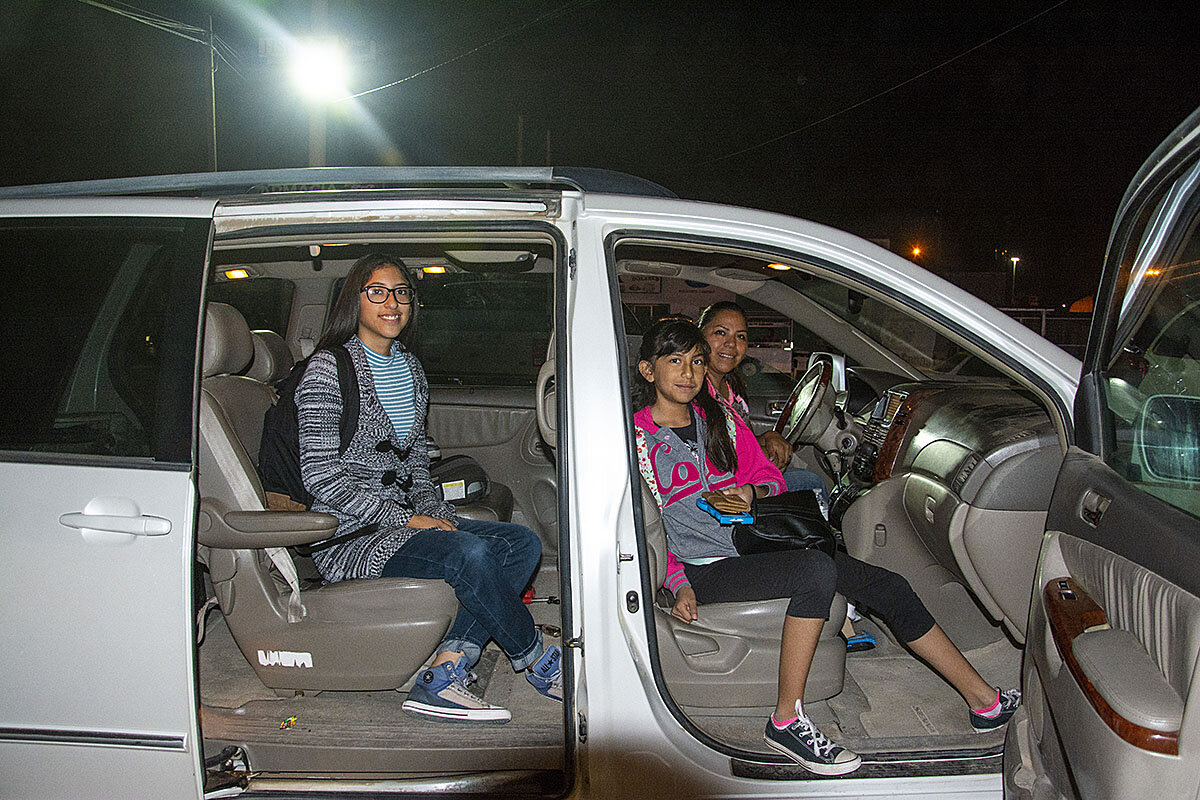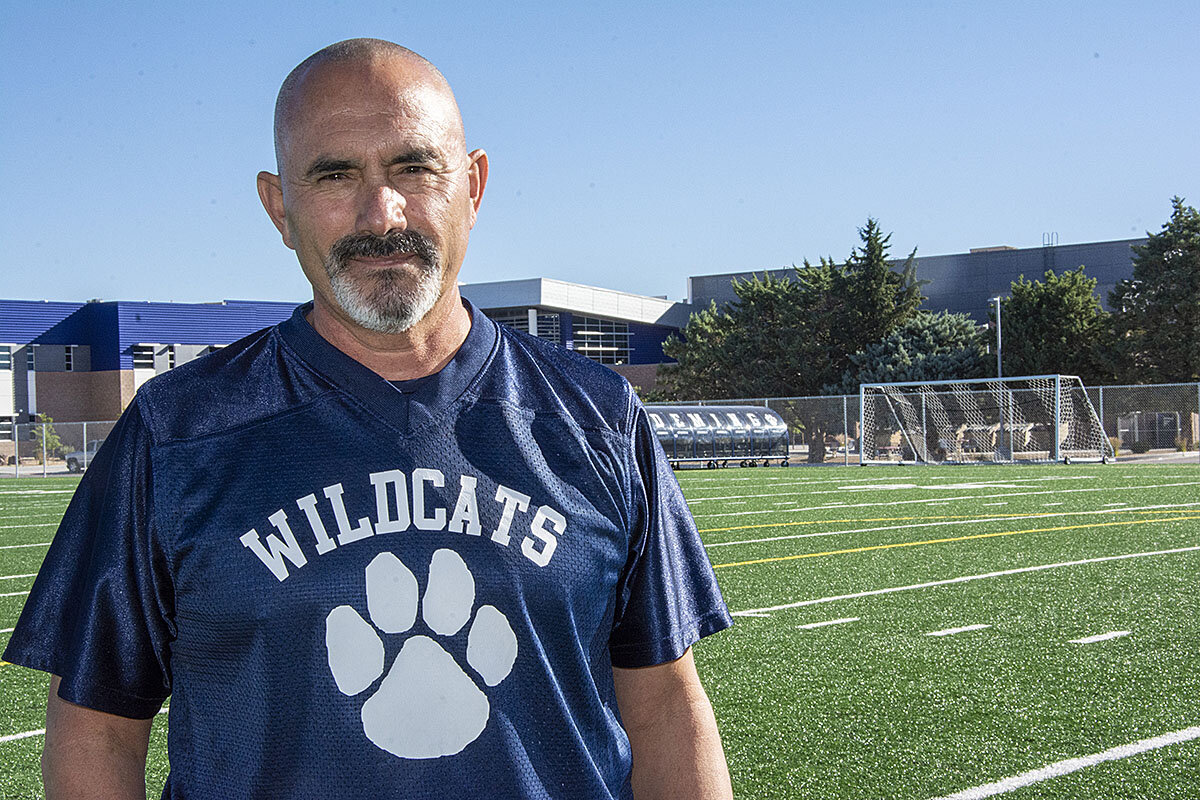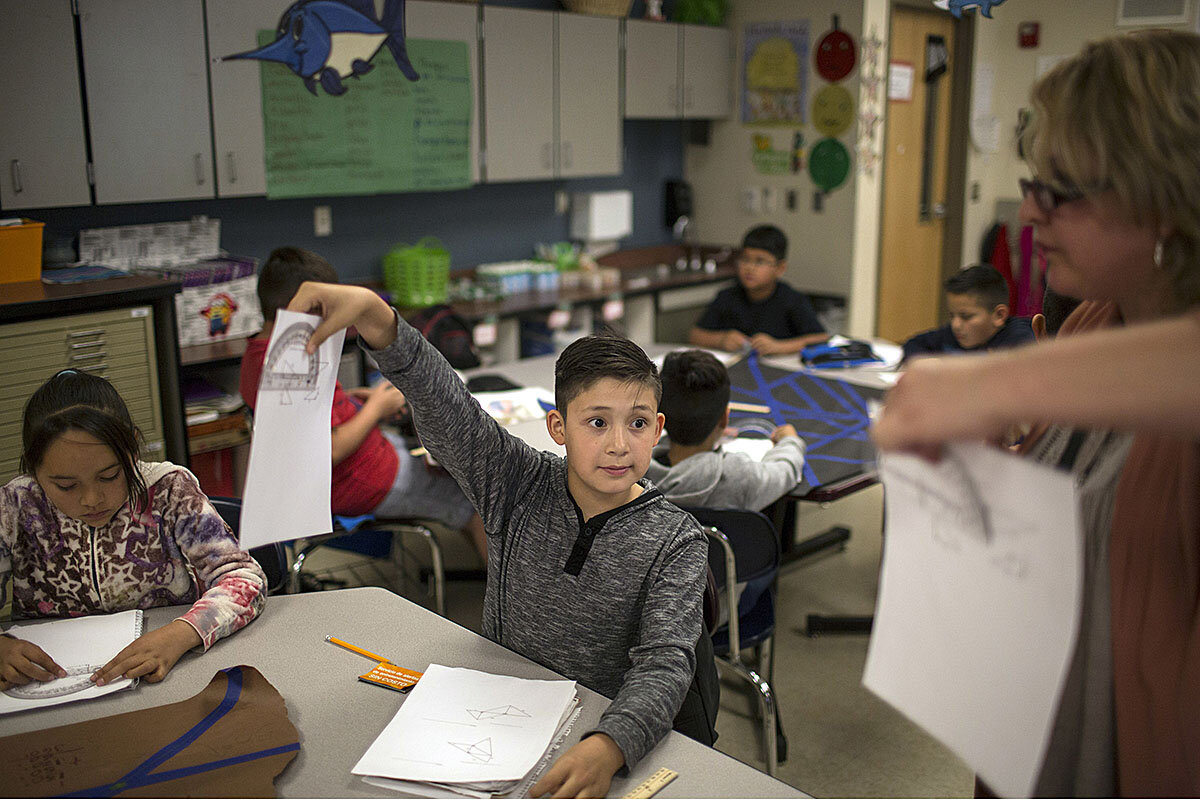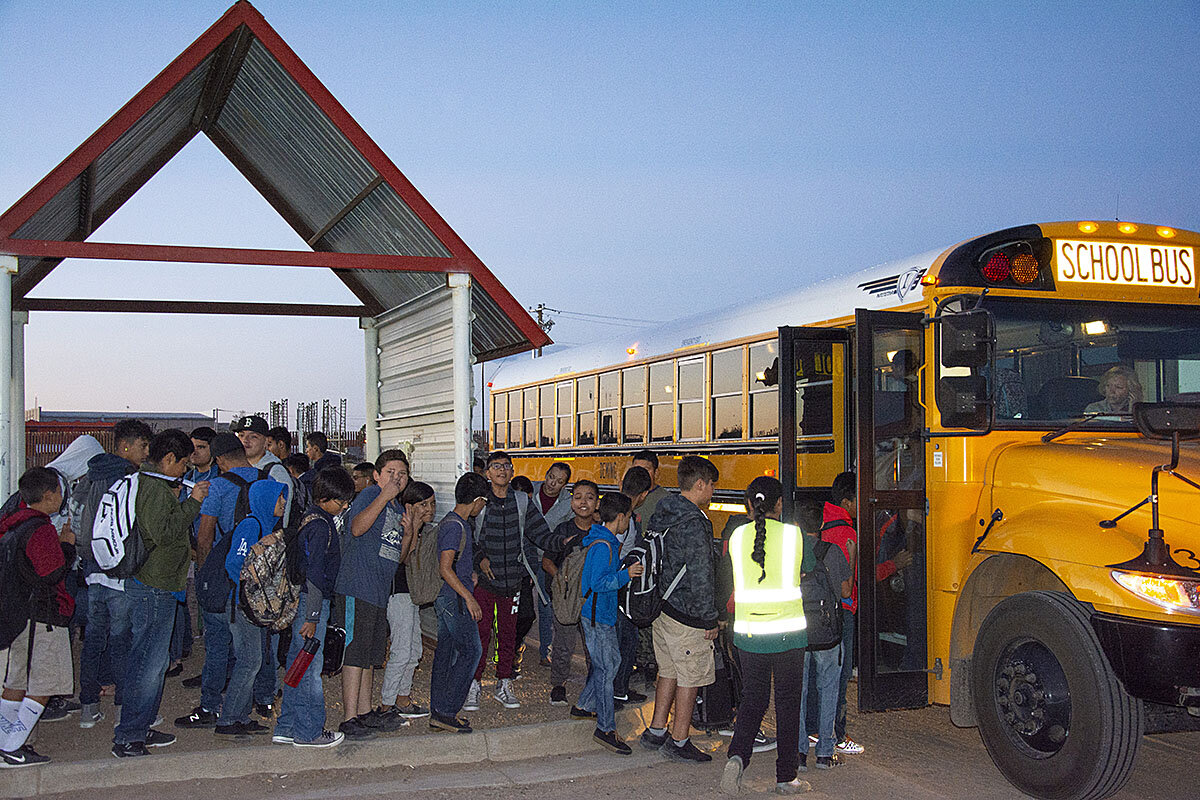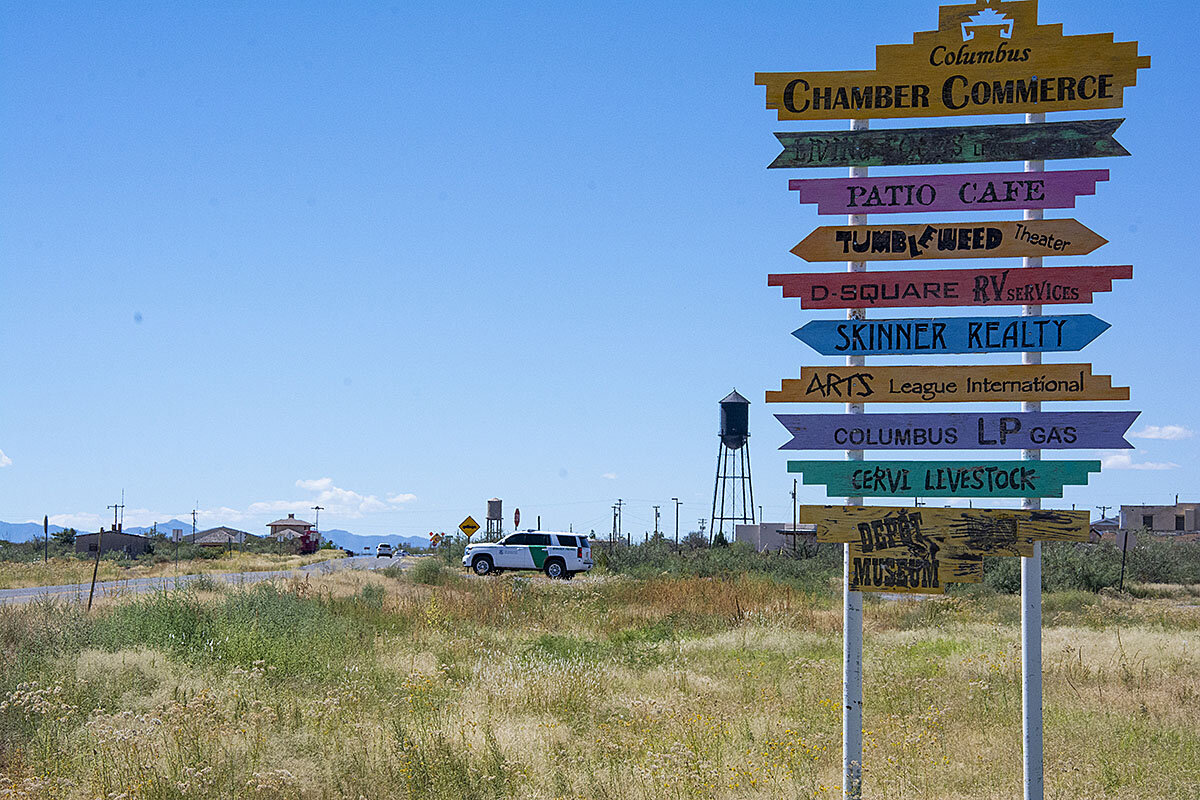A border, a bus, then school begins in New Mexico
Loading...
| Palomas, Mexico, and Deming, N.M.
Every school day, yellow buses run from the US-Mexico border to the public schools in Deming, New Mexico. Aboard these school buses are hundreds of Mexican-American students who live in Mexico with their families and study at US public schools. Their border-crossing schooling does not raise many eyebrows in Deming, which has long-standing ties with Palomas, its sister town on the other side. For decades, Mexican families have relied on medical services in Deming, while people in Deming go to Mexico for dental care. In recent years, more parents deported from the US to Mexico have moved close to the border so their US-born children can get a better education. At a time of intense national politicking over immigration ahead of next week’s midterm elections, it presents another side of binational cooperation. “We’re going to continue to accept them because they’re part of our community. They’re our friends, our neighbors, our family members,” says Arsenio Romero, superintendent of Deming Public Schools.
Why We Wrote This
Schools in some US border towns have long enrolled Mexican-American students living on the other side. Those who live there say the policy reveals complexities often missed in the national debate on immigration.
With her backpack slung over one shoulder, Gabriela Corona strolls toward the US-Mexico border as casually as if she is crossing the street to school. Which, in many ways, she is.
At this early hour it is so black outside that the scrubland seems to disappear, though the bright lights of the US port of entry punch the sky. Gabriela passes walls of barbed wire, camouflage-clad Mexican officers carrying big guns, and US border patrol agents who sit on stools inside the entry building with their arms crossed. On the far side of the building, on United States soil, the passageway narrows.
None of this fazes Gabriela. A junior in high school, she has been doing this for almost a decade. She is one of the 850 students who cross the border every weekday in Palomas, Mexico to attend school in Luna County, N.M. The students are all US citizens who live in or near Palomas with their Mexican parents. It is an arrangement that has been in place for generations, long enough to become natural in a region where economic and ancestral ties lace across the manmade line that divides the countries.
Why We Wrote This
Schools in some US border towns have long enrolled Mexican-American students living on the other side. Those who live there say the policy reveals complexities often missed in the national debate on immigration.
Palomas seems to organize itself around the school-day outflow. Women sell home-cooked food from tables near where parents drop off their kids. On the other side of the barbed wire, an American school bus is waiting. For Gabriela and her younger siblings, Alejandra and Diego, the bus represents an opportunity to attend a better school, or even to attend school at all. In Mexico, public education typically ends at age 15.
“It’s just like, awesome, because I have [this] opportunity every single day,” says Gabriela.
Nearly two years after President Trump won the presidency with promises to build a border wall and deport unauthorized immigrants, a record number of Americans see immigration as the leading problem facing the country. Ahead of the midterm elections in November, politicians have amplified a debate about the costs and benefits of immigration, and a convoy of Central Americans marching toward the US border has sharpened the controversy.
But people who live along this stretch of the US-Mexico border have a complicated understanding of immigration. It is not a black-and-white issue for residents of Luna County. Locals here, as elsewhere along the border, deal with the realities of keeping schools open, meeting health-care needs, and finding jobs or workers. In that context, coexistence is more important than winning Twitter wars.
“[T]he Luna County schools is an extremely interesting example of a community making its own judgments about what makes sense.... There is a different thought process behind what they are doing,” says Margie McHugh, director of the National Center on Immigrant Integration Policy at the Migration Policy Institute in Washington.
Opponents of Luna County’s education policy argue that US taxpayers shouldn’t pay to educate students who live in Mexico. But local leaders argue that their program makes economic sense: These students are the county’s next generation. They may live in Palomas today, says Mayor Benny Jasso of Deming, one of two towns whose public schools educate border-crossers, but it’s very likely they will live in the US later in life.
“I’d rather have them educated,” says Mayor Jasso, wearing a Deming High School “Wildcats” jersey with his name on the back. “I’d rather have them contributing and being a taxpayer and not be a drain on the system.”
A mixed-citizenship community
Local supporters are quick to remind opponents that the arrangement in Deming Public Schools is legal. Legal-ish.
A mixed-citizenship family structure is increasingly common along the border, but the ratio of these families in Palomas, a town of less than 5,000 people, is particularly high. Some Mexican-American families move to Palomas from within Mexico for the schooling arrangement, or local agricultural opportunities, or a combination of the two. And many families move to Palomas after one parent is deported since it allows children to use their US citizenship to study and work there.
Other families’ border crossings are a product of the area’s remoteness. The closest Mexican hospital is in Juarez, two hours east, so when soon-to-be mothers come to US Customs with labor pains, many patrol officers let them through to the hospital 45 minutes north in Deming.
For decades, New Mexico state and US federal policy approved this humanitarian arrangement. In 2010, Palomas agreed to renovate a small clinic and staff it around the clock. Now only expectant mothers with emergency medical needs are officially eligible to cross the border to give birth. The new arrangement has cut the number of such births in Deming approximately in half, to a reported 52 in 2017.
Under the 14th Amendment to the Constitution, children born on US soil automatically become US citizens. That’s what “birthright citizenship” is. It’s the law in more than 30 countries, including the US, Canada, and Mexico. Mr. Trump has said he wants to issue on executive order nullifying this long-accepted guarantee, but most legal experts say the president cannot do this with the stroke of pen.
As for education, state and local laws guarantee citizens the right to free public schools. Generally, students must have a local address to enroll in the local school – but it’s up to the local school district how far they go to investigate the legitimacy of the address.
Luna County schools have been accepting children who live in Mexico since the 1950s, largely due to Phoebe Watkins, a teacher who believed every child deserved a quality education. Back then, the students did not have to be American; it was only in the 1970s that the county began requiring US citizenship.
Luna County is not the only US border locale with this arrangement. A handful of students have for a long time crossed the border in Juarez to attend school in El Paso, Texas, and teachers in San Ysidro, Calif., estimate that as many as 1,000 students currently cross the border from Tijuana, Mexico, every day for school.
But Luna County stands out from the others not only by the proportion of border-crossers to local students – of the elementary school’s 600 students, 400 live in Mexico – but also by the community’s welcoming attitude. In both El Paso and San Ysidro, border crossers hide their identity: If students are found to be living outside of the district, school officials order them to pay the full cost of tuition or be expelled. Compare this to Deming, which sends yellow school buses down to the border every morning and every night.
“We’re going to continue to accept them because they’re part of our community. They’re our friends, our neighbors, our family members,” says Arsenio Romero, superintendent of Deming Public Schools. “I think it’s just different for the people in Luna County and in Palomas. We don't really have a term for it, they’re just all our kids.”
At the bus stop
Once they’ve passed through US Customs, Gabriela and Alejandra wait at their bus stop: a dirt parking lot less than 200 yards away from the fence where their mother dropped them off.
Like other schoolgirls at bus stops across America, Gabriela and Alejandra find their friends and start laughing. They talk rapidly in Spanish about boy bands and homework. The sky turns navy and then robin’s egg blue.
Shortly after Gabriela and Alejandra’s buses pull away for the 45-minute ride to Deming, more girls and boys, many no taller than a patrol agent’s hip, flood past the turnstiles carrying candy-colored backpacks and big bows. Their elementary school in Columbus, N.M., is only a 15-minute bus ride, so younger students, such as Gabriela and Alejandra’s kindergarten-age brother Diego, come across later.
Their father, Gregorio Corona, grew up in Palomas and he remembers feeling jealous of his neighbors who were US citizens and went to school in Columbus and Deming. “I asked my mother, ‘Why can they go over there and not me?’ ” says Corona.
Deming’s schools don’t typically arouse jealousy. When grading the district’s 11 schools for the 2017-2018 school year, New Mexico – which ranked 50th in the country this year for education – gave Deming six Ds, four Cs, and one B.
But Palomas families say any US education is superior to their schools in Mexico. Public education in Mexico is compulsory until middle school, at which point families decide if they can afford high school. Corona’s family could not: He left school with a ninth-grade education.
“Before they [were] born, we always think we always want the best for our kids,” says Gregorio, as he puts his arm around his wife, who is also named Alejandra, in an interview at his house. “We’ve given [the kids] the opportunity that we don’t have here in Mexico.”
A commuter’s choice
It’s not easy to be a border commuter: The Corona kids’ academics are much tougher than at home and they have almost a two-hour commute one-way. It’s clear that Corona, a young father with kind eyes, pushes his kids to study hard and not miss the morning bus. But when she’s alone, Gabriela says she would still choose a US education – even without her father’s pressure.
That’s why Mr. Romero, the Deming superintendent, thinks everyone in America should spend a morning at his border bus stop. The immigration debate has turned toxic, but watching five-year-olds walk through Customs with passports around their neck might change perceptions about who belongs in this country.
“It will change you, because you see this grit that these kids have from an early age.... They want to make this happen and they sacrifice to make it happen,” says Romero, shaking his head in amazement at their efforts.
What opposition there is to the school program comes mostly from older transplants to the region, say city officials. But their views don’t appear to be gaining ground.
And while a sentiment of “the way it’s always been” undergirds the local support, New Mexico’s unusual system for school funding plays a major role. Whereas most other states rely heavily on property taxes to fund local schools, New Mexico pools all of its education funding and then sends the money to districts on a per student basis.
Between Deming and Columbus, Mexico commuters make up more than 15 percent of the school population, which means more education dollars for a rural district. (Deming Public Schools is the city’s second-largest employer.)
Post-Trump border realities
But Corona says he has felt a change “since Donald Trump came.” He often crosses the border using his US visa to do odd jobs like yard work in Deming and Columbus, and has come to recognize – and even befriend – some of the Border Patrol agents. Now many of them are less friendly. He says one even threatened to take his visa – something that had never happened before.
“It seems like it’s more acceptable to be able to say things that you couldn’t say a couple years ago,” says Romero. “And that’s absolutely the truth with these students.”
At Deming High, Gabriela says the Palomas kids have been treated differently over the past year. She’s silent for a minute, trying to think of the right word in English to describe the treatment. Finally, she nods her head and says “racism.” The Palomas kids and the Deming kids have always had their respective cliques in the high school, says Gabriela. But recently there have been fights between the two groups – something she had never seen before.
“The white kids say, ‘You shouldn’t be here,’ ” says Gabriela. “You should be back over [the border].”
At the Walmart in Deming, older white couples peruse the aisles with canes and motorized scooters; young Hispanic couples hold up baby clothes. Most of the workers restocking the shelves are also Hispanic. While picking out pet food, Edie Scheller talks about how much she dislikes Deming. She moved here six months ago from Phoenix, a place she characterizes as much more strict – rightfully so, she says – on immigration.
“I don’t feel safe here,” says Ms. Scheller. “You never know who is going to pop out.”
Loading her plastic bags into her car one at a time, Arlene Beem says she’s fine with the city’s school program, “as long as they don’t bring the drugs.” Her husband, Fred, takes a harder line.
"A woman gets pregnant and then when she’s in labor she comes to the border and we pay the bill,” says Mr. Beem. “[The students] will come across, bring their parents, and all be on welfare.”
Jasso, the city’s mayor, has heard this opinion a lot lately, and with the president pushing a narrative of Mexicans as criminals, this doesn’t surprise him. He understands that, to some, Deming’s busing program may look like another handout.
But Jasso tries to remind locals like Mr. Beem that educating these young US citizens is the best way to build the local tax base for a rural town with a shrinking population, as well as reduce future national handouts like welfare.
“Our whole goal is to get [children] educated. Make them productive citizens,” says Jasso. “They’re going to come back and they’re going to be the future leaders. They're going to be the next round of business people. They’re going to be the ones that are that are contributing to this community and making it a great community.”
Jasso’s own family is an example. After his Mexican grandparents immigrated to New Mexico in 1916 in a covered wagon, Jasso’s father and six uncles served in the US military. Jasso worked as a firefighter for 22 years before being elected mayor in 2014.
These are the stories that residents here say America has largely forgotten: the best elements of the country’s intertwined history with Mexico.
Border crossing as a way of life
In recent months, President Trump has reworked the North American Free Trade Agreement after repeatedly criticizing trade with Mexico. He’s rallied Republican votes ahead of the midterm elections by painting Democrats as proponents of “open borders,” and therefore, more crime. In 2016, he carried Luna County by nearly four points, a wider margin than Mitt Romney in 2012.
Still, in much of Luna County, “open border” isn’t a dirty phrase, but rather a way of life.
Many Columbus and Deming residents, for example, visit a dentist in Palomas. Americans who live in Columbus eat dinner in Palomas, as their own town’s two main restaurants close before 6 p.m.
Philip Skinner, a former mayor of Columbus who now drives the elementary school’s bus to and from the border, has his own favorite, Casa Mexicana. He eats at the five-table restaurant with lime green walls off of Palomas’s main plaza three or four times a week. The owner, Maritza, expects him, and she cooks Skinner’s favorite: hot chicken enchiladas with homemade chile and a sugary agua fresca.
“I’m a conservative Republican, not a Trump Republican, but I’m a conservative so I see rule of law,” he says. “People shouldn’t be crossing the border illegally.”
But then there are the kids who pile into his bus every day, bound for their American classrooms. “I’m not an open border guy. But I can also see the humanitarian side of educating these children.”
Cross-border education binds together the communities on both sides. If a child gets hurt or has disciplinary issues, Romero often calls Palomas’s mayor, who will go knock on the door of families who don’t have phones. And whenever Deming Public Schools buys new books or desks, Romero often donates the old supplies to Palomas.
During parent-teacher conferences, many Mexican parents can’t visit their child’s school in person. Deming’s teachers used to travel to Palomas for conferences until a decade ago, says Romero, when the district’s insurance made it cost-prohibitive. Now, Deming Public Schools works with Palomas’ government to set up Skype sessions for families at an internet café.
“They’re our partners in this,” says Romero.
A father’s hopes and dreams
Corona admits it was hard waving goodbye to Gabriela almost 11 years ago when she began kindergarten in Columbus. “But we trust them,” he says. “We trust the schools.”
After she graduates from Deming High School next year, Gabriela wants to go to college in Las Cruces, N.M., and become a nurse.
But for now, at her pink stucco home in Palomas, where her dog Milo runs collarless around the neighborhood, Gabriela thinks of her diploma. It will represent more than a high school degree – it will represent years of early alarm clocks, hours of homework on long, winding bus rides, and all the mornings she spent under a cold, black sky in the Customs’ dirt parking lot.
When Gregorio Corona thinks of Gabriela’s graduation day, he sounds like many other nostalgic fathers in America.
“I thought that that would happen in a long time, but we are there,” he says, laughing.
And Gabriela’s diploma will mean something for him as well.
“It’s going to be an amazing, that my daughter can go to college,” says Corona. “She can do what I can’t. What’s impossible for me. It’s going to be a big success for her – and for me.”






